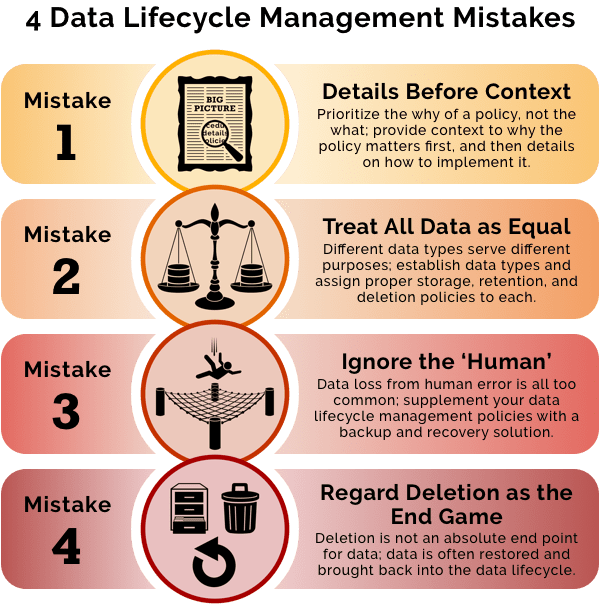Backup
Cloud and Data Security4 Data Lifecycle Management Mistakes Businesses Should Avoid
Learn the basics of data lifecycle management and how to avoid data lifecycle management mistakes that can be costly to your data and business.
By
Dave Wallen
4 minute read
Data – lifecycle – management! There’s a lot of confusion about what these words mean when used together. A major reason for data lifecycle management mistakes is the term’s vague understanding within the tech community; it’s seen as an abstract concept that can be interpreted in more ways than one. Let’s start on the right foot by accurately defining data lifecycle management.
What is data lifecycle management?
To protect your data, you need to know your data — where is data getting created, stored, used, tampered, and deleted. Data lifecycle management is a policy-based approach that manages the path of data throughout its lifecycle: creation to deletion.
Data lifecycle management policies help businesses manage the enormous size, variations, and velocity of incoming data. Businesses enjoy lower storage costs, higher business performance, greater margins, and better data protection. However, the pay-off occurs only when data lifecycle policies are successful. This is easier said than done.
Data lifecycle management mistakes are far too common than we like to accept. It’s highly frustrating for businesses to invest resources in setting up data lifecycle management policies and not reaping the benefits of it.
Data Lifecycle Management Mistakes to Avoid
To get the most out of your data lifecycle policies, avoid these four data lifecycle management mistakes:
Mistake #1: Details Before Context
Businesses tend to communicate the what of policy, not the why. Implementing a data lifecycle management policy means everyone needs to be on board because each employee has a part to play. The only way that’s going to happen is when you offer context to why the policy matters to the business and how it will impact employees.
Create a comprehensive data management plan: context first and then the details on how to implement it. A good strategy is to assign a person that keeps track of data lifecycle processes like handling data storage, retention, deletion, and communicates the same to get the entire business on the same page.
Mistake #2: Treat All Data as Equal
Customer data will be managed differently from accounting data for a simple reason — they serve different business purposes. The truth is that each data set has its significance and treating all of it as one big entity can be an expensive mistake.
Establish data types right at the collection stage but do keep in mind, data sets might jump from one type to another throughout the lifecycle as its utility alters. You can customize retention policies, storage capacity, deletion methods for each data type.
For instance, a popular classification method is to club data based on its value to the business. Some of the data types are public, internal, sensitive, or restricted. Each data type will have its unique policies for storage, retention, and deletion.
Mistake #3: Ignore the ‘Human’
One-quarter of data loss is due to human error. Often, businesses tend to disregard this trend simply because nobody wants to point fingers at their own people. For many of them, it ends up as an expensive and painful lesson.
Sadly, you can’t prevent human errors but, you can prevent the repercussions of data loss. As you set up your data lifecycle management policies, simultaneously install a good backup solution. Keep an additional copy of data that lives on physical storage or the cloud to avoid any financial or legal backlash that results from unplanned downtime.
Mistake #4: Regard Deletion as the End Game
Many businesses run with a misconception that at the end of the lifecycle, data is either retained or destroyed. In reality, data is either retained, destroyed, or restored.
Data might be deleted by human error, natural disasters, or cyberattacks. Already-disposed data might contain information that may be significant later. Use a recovery solution to restore lost data seamlessly and ensure business continuity.
SaaS Backup: A Key Component of Data Lifecycle Management
Poorly executed data lifecycle management policies lead to catastrophic data loss incidents. It peters out all your data lifecycle management efforts but more importantly, puts an indefinite hold on your business operations.
A good SaaS backup shields you from the aftermath of data lifecycle mistakes. However, a wrong backup solution aggravates the situation by putting your stored data at a greater risk.
Download our whitepaper Securing Your SaaS Backup to develop a comprehensive security strategy for your SaaS backup.
Ask the right questions – find the right answers – choose the right SaaS backup.
Get the Whitepaper